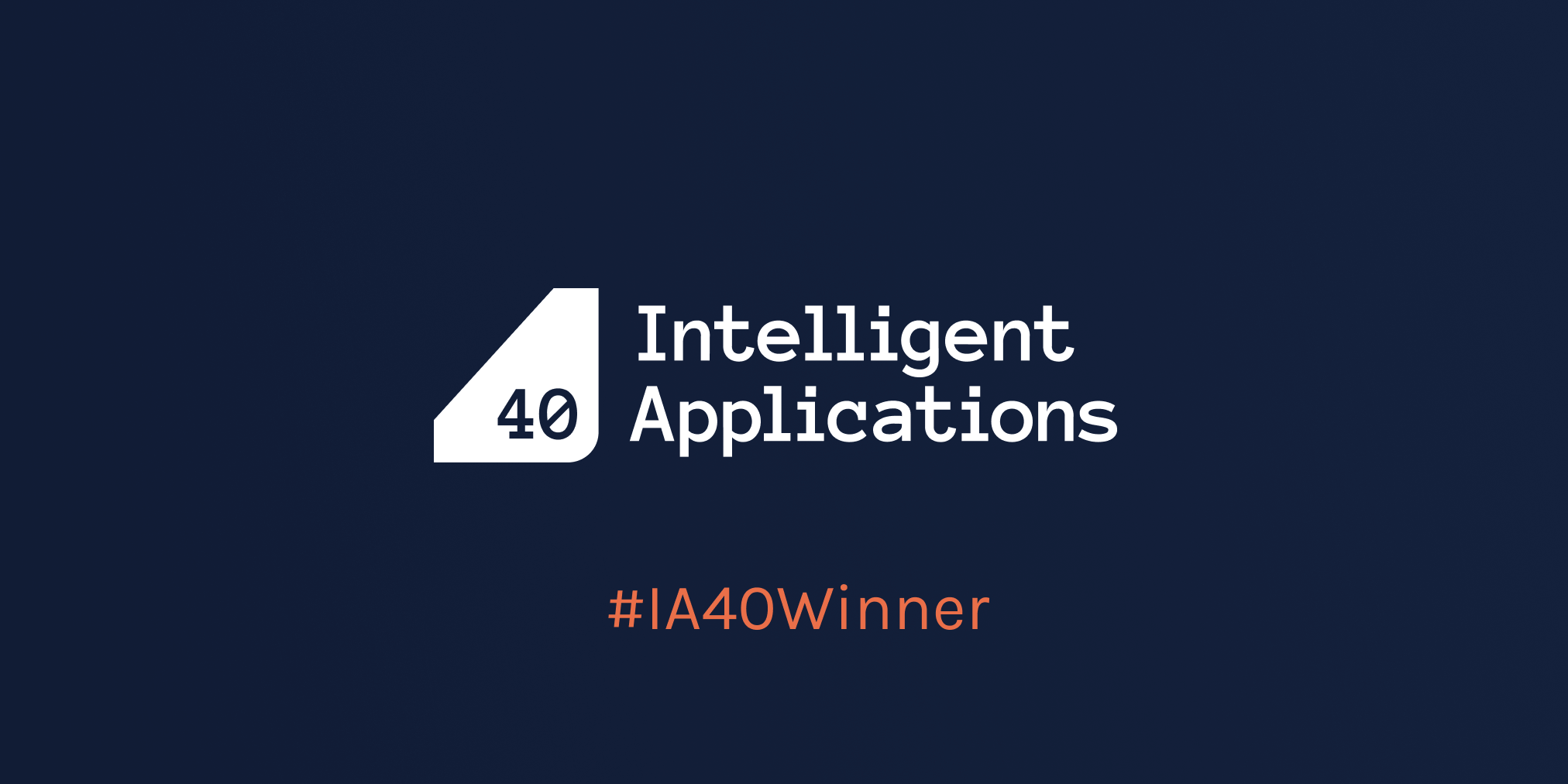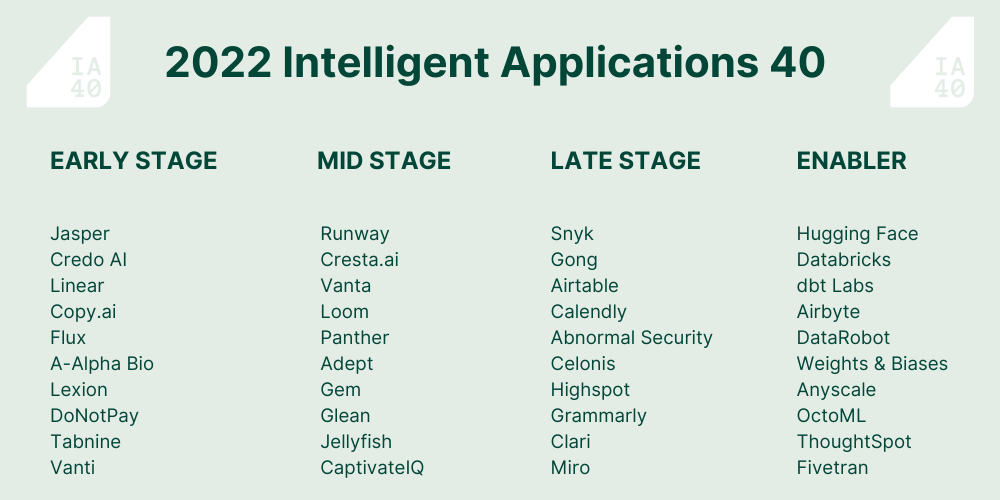Voted on by top investors and leveraging PitchBook’s ML/AI algorithm, these are the top private companies building intelligent applications today.
Today, Madrona, Goldman Sachs, Microsoft, Amazon Web Services, and PitchBook are excited to announce the 2022 Intelligent Applications 40. Madrona, a longtime investor in data science differentiated companies, helped establish the inaugural IA40 List last year. This year, we worked in partnership with PitchBook to enhance the overall methodology with PitchBook’s AI-driven approach to identifying high-potential companies. We also enlisted over 50 venture capital investors from over 40 top-tier venture capital and investment firms to nominate and vote on the top companies shaping the future of intelligent applications.
Madrona believes the next generation of applications will leverage diverse and proprietary data sources, large language models, and machine intelligence to turn software into dynamic and predictive systems of intelligence.
We are excited to announce this year’s list amidst the booming hype cycle around generative AI. In recent weeks, we have seen significant VC investment and interest in intelligent applications with Stability AI’s $101 million funding round, followed by Jasper’s $125 million Series A funding round completed at a $1.5 billion valuation. While the hype may be high, we are excited to see our long-term thesis of intelligent applications playing out in real-time across areas as diverse as the creator economy, business applications, and computational biology.
Highlighting how dynamic the field of applied ML/AI has become, the IA40 2022 list has 27 new winners and 13 repeats. The winners span many different verticals, including developer tools, marketing, sales enablement, collaboration, security, future of work, life sciences, and more. These companies have raised over $16 billion of total capital since inception (including $5 billion since the start of the year) and come from around the world — Seattle, San Francisco, New York, Tel Aviv, Munich, and all points in between.
We invite you to dive into the full details of the list and be inspired by their desire to redefine the future of software! We will recognize this year’s winners at our inaugural 2022 Intelligent Applications 40 Summit next week in Seattle on November 1st and 2nd. If you are a founder building intelligent applications and are interested in attending this inaugural event, you can find more details on the event site or email [email protected].
The IA40 Companies are split across four categories
Funding data categorized as of 9/30/2022
- Early – Up to $30M total capital raised
- Mid – $30M – $200M total capital raised
- Late – $200M+ total capital raised
- Enablers – Stage Agnostic. (We define enablers as the companies building the tools and infrastructure that enable intelligent applications)
Thematic Insights from the 2022 IA40
Foundation Models: The biggest shift from last year is the number of companies building on top of foundation models. These foundation models, such as GPT-3, DALL-E, Flamingo, and Stable Diffusion, were still emergent last year, and business models were still unclear. In 2022, and in the last week alone, we are seeing many early-stage companies emerge leveraging these models for a wide range of tasks, such as text, image, code, and video generation. Several winners this year, such as Runway, Jasper, Copy.ai, and Tabnine, are great examples of impressive applications built on top of foundation models. We believe intelligent application creation will accelerate with foundation models, and as the tooling and data quality improves, companies can build even more defensible businesses.
Intelligent Application Enablers: We saw the most repeat winners in the Enabler category this year, with Hugging Face, Databricks, dbt Labs, DataRobot, OctoML, and Fivetran landing on the list for the second time. Enabling layers will continue to be at the forefront of innovation as these are the critical tooling and infrastructure layers that allow for intelligent applications to be built. We are starting to see more enablers focused on solving key pain points around ML workflows and analyzing and utilizing unstructured data.
Massive computational power and low-cost storage: This has created the infrastructure layer needed to train machine learning models. Marked improvements in tools and frameworks make it easier for companies and developers to begin using machine learning in their applications. This has resulted in a Cambrian explosion of companies building applications on top of foundation models.
Leveraging Real-Time Data and AI to Power Insights: Real-time assistance and real-time analytics are some of the biggest trends we are seeing across mid-stage and late-stage companies. Companies such as Cresta.ai are leveraging real-time analytics in the contact center, and companies such as Gong, Clari, and Highspot are leveraging real-time data for sales enablement. These companies are collecting real-time data from different data sets (structured, unstructured, audio, telephony) to deliver real-time assistance and insights that can help drive business efficiencies and revenue. More data is being generated and stored than ever before across fields like finance, healthcare, autonomous systems, and media — and that data is used to train ever-better machine learning models.
Increasing Number of Collaboration and Communication Tools: Another shift this year is the recognition that collaboration tools that make teams more productive in the digital sphere are also driven by intelligence. Some of these are obvious business productivity tools, such as Airtable, Loom, and Calendly, but we are also seeing novel ideas, such as Flux, which helps teams work on one platform to design hardware and Jellyfish, which helps engineering teams stay focused on business priorities. We anticipate these companies will continue to leverage AI to become more intelligent and will move into more vertical and horizontal markets.
Financial Insights From the 2022 IA40
- Despite the choppy financial markets, the 2022 IA40 winners raised $5 billion of capital from the beginning of the year through Sept. 30, 2022, which was the cutoff for this year’s categorization. Note that our cutoff was before Jasper’s $125 million raise at a $1.25 billion valuation. This would have bumped the total dollars raised and moved Jasper into the mid-stage category.
- Looking at funding since inception, the 2022 IA40 winners have raised a total of $16.1 billion, with the majority of the capital coming from the late stage, $7.4 billion, and the enabler stage, $7.1 billion.
- We anticipate many of the IA40 2022 winners in the late stage will be actively looking at M&A opportunities in the next year to further strengthen themselves prior to IPO. We also anticipate many of these companies will be primed to go public within the next year.
As AI/ML models have matured and become more widely adopted in the developer community, their potential to be deployed in business applications has become more apparent. At Madrona, we have been partnering with and investing in intelligent application companies for the last 10 years and watching their impact across many verticals. These applications will define the future of software and the next generation of computing, and we believe they deserve to be known and recognized!
2022 Process & Methodology
Creating the 2022 IA40 list was a multi-step process that included enlisting over 50 judges from over 40 top venture capital firms to nominate and vote and working with our new partner, PitchBook, to leverage their data and algorithms.
Nominations — We received over 250 private company nominations from over 50 venture capital investors from over 40 top-tier venture capital and investment firms. This year, we also partnered with PitchBook to further expand our nomination list by identifying the top-performing companies in the intelligent applications sector to ensure we were not missing out on any companies.
Voting — After we collected the nominations, we asked the same venture capital investors to vote on their top 5 companies in each sector (early, mid, late, and enabler). Each venture capital investor was limited to voting for only 2 of their portfolio companies. We also leveraged PitchBook’s “Venture Exit Predictor Tool.” Their model considers and weighs many data points, including total venture dollars raised, number of employees, and latest post-money valuation. We weighted the venture community votes and PitchBook’s Venture Exit Predictor Score to produce a final composite score that resulted in the 40 winners.

